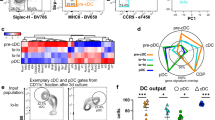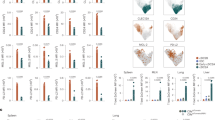Abstract
The development of functionally specialized subtypes of dendritic cells (DCs) can be modeled through the culture of bone marrow with the ligand for the cytokine receptor Flt3. Such cultures produce DCs resembling spleen plasmacytoid DCs (pDCs), CD8+ conventional DCs (cDCs) and CD8− cDCs. Here we isolated two sequential DC-committed precursor cells from such cultures: dividing 'pro-DCs', which gave rise to transitional 'pre-DCs' en route to differentiating into the three distinct DC subtypes (pDCs, CD8+ cDCs and CD8− cDCs). We also isolated an in vivo equivalent of the DC-committed pro-DC precursor cell, which also gave rise to the three DC subtypes. Clonal analysis of the progeny of individual pro-DC precursors demonstrated that some pro-DC precursors gave rise to all three DC subtypes, some produced cDCs but not pDCs, and some were fully committed to a single DC subtype. Thus, commitment to particular DC subtypes begins mainly at this pro-DC stage.
This is a preview of subscription content, access via your institution
Access options
Subscribe to this journal
Receive 12 print issues and online access
$209.00 per year
only $17.42 per issue
Buy this article
- Purchase on SpringerLink
- Instant access to full article PDF
Prices may be subject to local taxes which are calculated during checkout





Similar content being viewed by others
Change history
19 October 2007
In the version of this article initially published online, the outlined boxes in the flow cytometry plots in Figure 5d are incorrect. The error has been corrected for all versions of the article.
25 October 2007
In the HTML version of this paper published online, Figure 2 was missing and a duplicate copy of Figure 4 was included in its place. This error has been corrected in the HTML version of the paper.
References
Shortman, K. & Naik, S.H. Steady-state and inflammatory dendritic-cell development. Nat. Rev. Immunol. 7, 19–30 (2007).
Vremec, D., Pooley, J., Hochrein, H., Wu, L. & Shortman, K. CD4 and CD8 expression by dendritic cell subtypes in mouse thymus and spleen. J. Immunol. 164, 2978–2986 (2000).
Geissmann, F., Jung, S. & Littman, D.R. Blood monocytes consist of two principal subsets with distinct migratory properties. Immunity 19, 71–82 (2003).
Naik, S.H. et al. Intrasplenic steady-state dendritic cell precursors that are distinct from monocytes. Nat. Immunol. 7, 663–671 (2006).
Randolph, G.J., Inaba, K., Robbiani, D.F., Steinman, R.M. & Muller, W.A. Differentiation of phagocytic monocytes into lymph node dendritic cells in vivo. Immunity 11, 753–761 (1999).
Serbina, N.V., Salazar-Mather, T.P., Biron, C.A., Kuziel, W.A. & Pamer, E.G. TNF/iNOS-producing dendritic cells mediate innate immune defense against bacterial infection. Immunity 19, 59–70 (2003).
Wu, L. et al. Development of thymic and splenic dendritic cell populations from different hemopoietic precursors. Blood 98, 3376–3382 (2001).
Manz, M.G., Traver, D., Miyamoto, T., Weissman, I.L. & Akashi, K. Dendritic cell potentials of early lymphoid and myeloid progenitors. Blood 97, 3333–3341 (2001).
D'Amico, A. & Wu, L. The early progenitors of mouse dendritic cells and plasmacytoid predendritic cells are within the bone marrow hemopoietic precursors expressing Flt3. J. Exp. Med. 198, 293–303 (2003).
Karsunky, H., Merad, M., Cozzio, A., Weissman, I.L. & Manz, M.G. Flt3 ligand regulates dendritic cell development from Flt3+ lymphoid and myeloid-committed progenitors to Flt3+ dendritic cells in vivo. J. Exp. Med. 198, 305–313 (2003).
Diao, J., Winter, E., Chen, W., Cantin, C. & Cattral, M.S. Characterization of distinct conventional and plasmacytoid dendritic cell-committed precursors in murine bone marrow. J. Immunol. 173, 1826–1833 (2004).
Fogg, D.K. et al. A clonogenic bone marrow progenitor specific for macrophages and dendritic cells. Science 311, 83–87 (2006).
Ginhoux, F. et al. Langerhans cells arise from monocytes in vivo. Nat. Immunol. 7, 265–273 (2006).
Nikolic, T., de Bruijn, M.F., Lutz, M.B. & Leenen, P.J. Developmental stages of myeloid dendritic cells in mouse bone marrow. Int. Immunol. 15, 515–524 (2003).
McKenna, H.J. et al. Mice lacking Flt3 ligand have deficient hematopoiesis affecting hematopoietic progenitor cells, dendritic cells, and natural killer cells. Blood 95, 3489–3497 (2000).
Brawand, P. et al. Murine plasmacytoid pre-dendritic cells generated from Flt3 ligand-supplemented bone marrow cultures are immature APCs. J. Immunol. 169, 6711–6719 (2002).
Brasel, K., De Smedt, T., Smith, J.L. & Maliszewski, C.R. Generation of murine dendritic cells from Flt3-ligand-supplemented bone marrow cultures. Blood 96, 3029–3039 (2000).
Gilliet, M. et al. The development of murine plasmacytoid dendritic cell precursors is differentially regulated by FLT3-ligand and granulocyte/macrophage colony-stimulating factor. J. Exp. Med. 195, 953–958 (2002).
Naik, S.H. et al. Cutting edge: Generation of splenic CD8+ and CD8– dendritic cell equivalents in Fms-like tyrosine kinase 3 ligand bone marrow cultures. J. Immunol. 174, 6592–6597 (2005).
Maraskovsky, E. et al. Dramatic increase in the numbers of functionally mature dendritic cells in Flt3 ligand-treated mice: multiple dendritic cell subpopulations identified. J. Exp. Med. 184, 1953–1962 (1996).
Kondo, M., Weissman, I.L. & Akashi, K. Identification of clonogenic common lymphoid progenitors in mouse bone marrow. Cell 91, 661–672 (1997).
Akashi, K., Traver, D., Miyamoto, T. & Weissman, I.L. A clonogenic common myeloid progenitor that gives rise to all myeloid lineages. Nature 404, 193–197 (2000).
Onai, N. et al. Identification of clonogenic common Flt3+M-CSFR+ plasmacytoid and dendritic cell progenitors in mouse bone marrow. Nat. Immunol. (in the press) (2007).
Laouar, Y., Welte, T., Fu, X.Y. & Flavell, R.A. STAT3 is required for Flt3L-dependent dendritic cell differentiation. Immunity 19, 903–912 (2003).
Suzuki, S. et al. Critical roles of interferon regulatory factor 4 in CD11bhighCD8α– dendritic cell development. Proc. Natl. Acad. Sci. USA 101, 8981–8986 (2004).
Janssen, E. et al. Efficient T cell activation via a Toll-interleukin 1 receptor-independent pathway. Immunity 24, 787–799 (2006).
Dettke, M. et al. Increased serum Flt3-ligand in healthy donors undergoing granulocyte colony-stimulating factor-induced peripheral stem cell mobilization. J. Hematother. Stem Cell Res. 10, 317–320 (2001).
Haidar, J.H. et al. Serum Flt3 ligand variation as a predictive indicator of hematopoietic stem cell mobilization. J. Hematother. Stem Cell Res. 11, 533–538 (2002).
Lyman, S.D. et al. Plasma/serum levels of Flt3 ligand are low in normal individuals and highly elevated in patients with Fanconi anemia and acquired aplastic anemia. Blood 86, 4091–4096 (1995).
Franchini, M. et al. Dendritic cells from mice neonatally vaccinated with modified vaccinia virus Ankara transfer resistance against herpes simplex virus type I to naive one-week-old mice. J. Immunol. 172, 6304–6312 (2004).
Naik, S., Vremec, D., Wu, L., O'Keeffe, M. & Shortman, K. CD8α+ mouse spleen dendritic cells do not originate from the CD8α– dendritic cell subset. Blood 102, 601–604 (2003).
Kamath, A.T. et al. The development, maturation, and turnover rate of mouse spleen dendritic cell populations. J. Immunol. 165, 6762–6770 (2000).
Diao, J. et al. In situ replication of immediate dendritic cell (DC) precursors contributes to conventional DC homeostasis in lymphoid tissue. J. Immunol. 176, 7196–7206 (2006).
Hochrein, H. et al. Herpes simplex virus type-1 induces IFN-α production via Toll-like receptor 9-dependent and -independent pathways. Proc. Natl. Acad. Sci. USA 101, 11416–11421 (2004).
Metcalf, D., Di Rago, L. & Mifsud, S. Synergistic and inhibitory interactions in the in vitro control of murine megakaryocyte colony formation. Stem Cells 20, 552–560 (2002).
Carotta, S., Brady, J., Wu, L. & Nutt, S.L. Transient Notch signaling induces NK cell potential in Pax5-deficient pro-B cells. Eur. J. Immunol. 36, 3294–3304 (2006).
Acknowledgements
We thank K. Gray and T. Berketa for animal husbandry; L. Di Rago and S. Mifsud for technical assistance with colony assays; F. Battye, F. van Diepen and the flow cytometry facilities for cell sorting and analysis; A. Keller and R. Schotte for technical assistance; and K. McIntosh for assistance with the manuscript. The Chinese hamster ovary cell line producing recombinant mouse Flt3L was provided by N. Nicola (The Walter and Eliza Hall Institute). Supported by the National Health and Medical Research Council, Australia; the Marie Curie foundation (039477 to S.H.N.); and the Korean Science and Engineering Foundation through the Medical Research Centre for Cancer Molecular Therapy, Dong-A University (J.-Y.K. and H.-Y.P.).
Author information
Authors and Affiliations
Contributions
S.H.N. designed and did most experiments and wrote the manuscript; K.S. designed experiments and wrote the manuscript; P.S. and H.-Y.P. isolated bone marrow precursor cells and did clonal experiments; J.-Y.K., M.O.'K. and L.W. helped to design experiments; D.M. did and analyzed colony assays; A.I.P. and A.D. assisted with precursor characterization; S.C. did the OP9 B precursor assays; M.B. and A.P. designed and did the statistical analysis; and all authors discussed the results and helped to write the manuscript.
Corresponding authors
Supplementary information
Supplementary Text and Figures
Supplementary Figures 1–5 and Tables 1–2 (PDF 4507 kb)
Rights and permissions
About this article
Cite this article
Naik, S., Sathe, P., Park, HY. et al. Development of plasmacytoid and conventional dendritic cell subtypes from single precursor cells derived in vitro and in vivo. Nat Immunol 8, 1217–1226 (2007). https://doi.org/10.1038/ni1522
Received:
Accepted:
Published:
Issue Date:
DOI: https://doi.org/10.1038/ni1522



